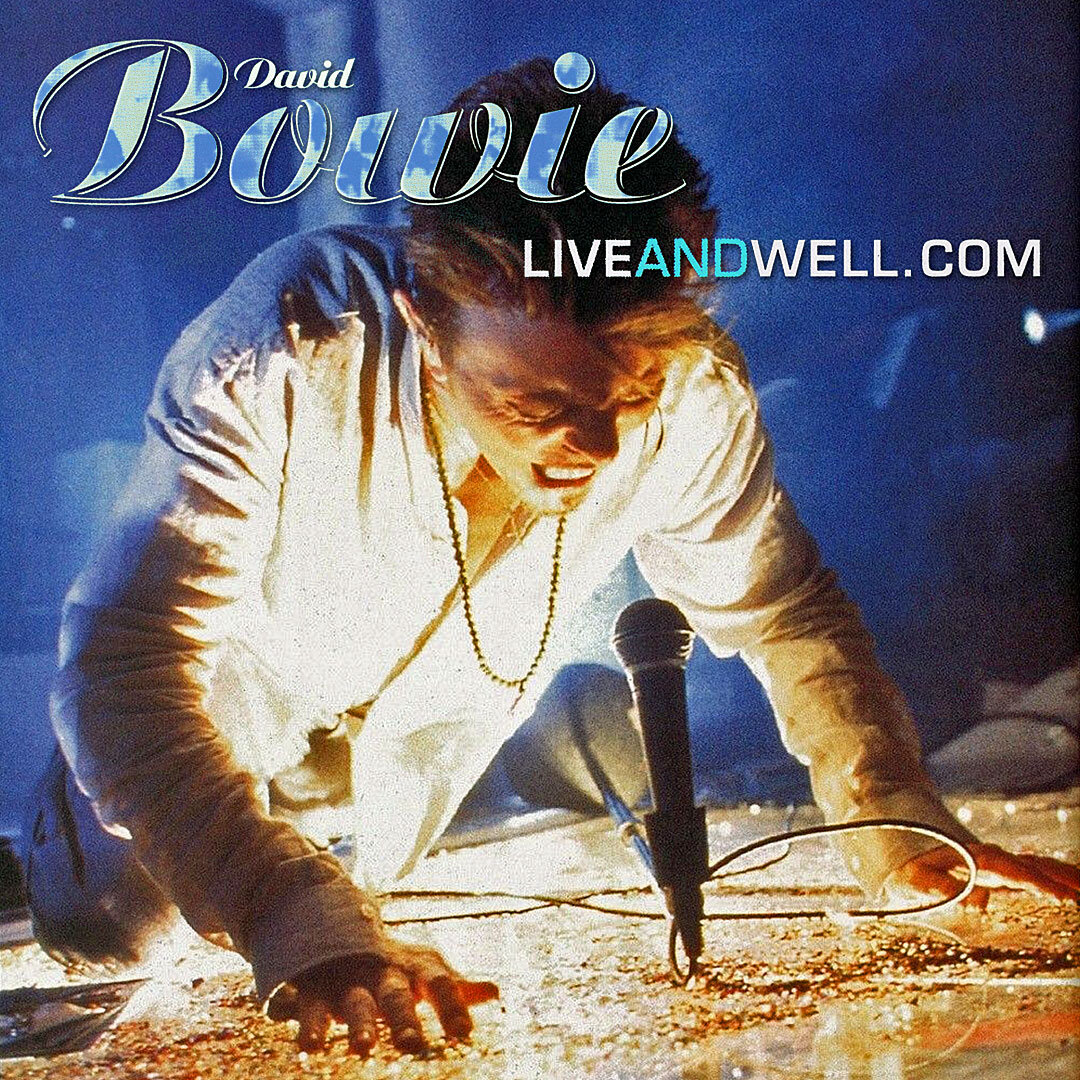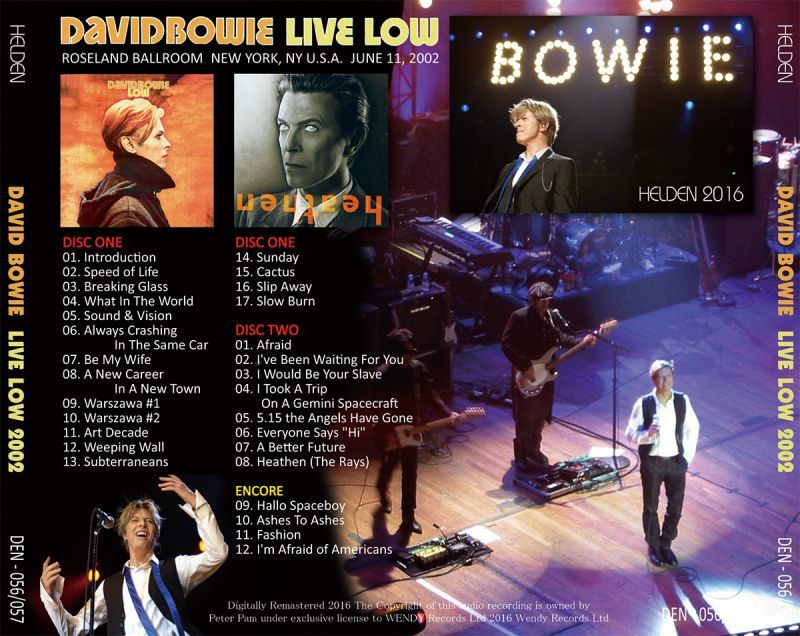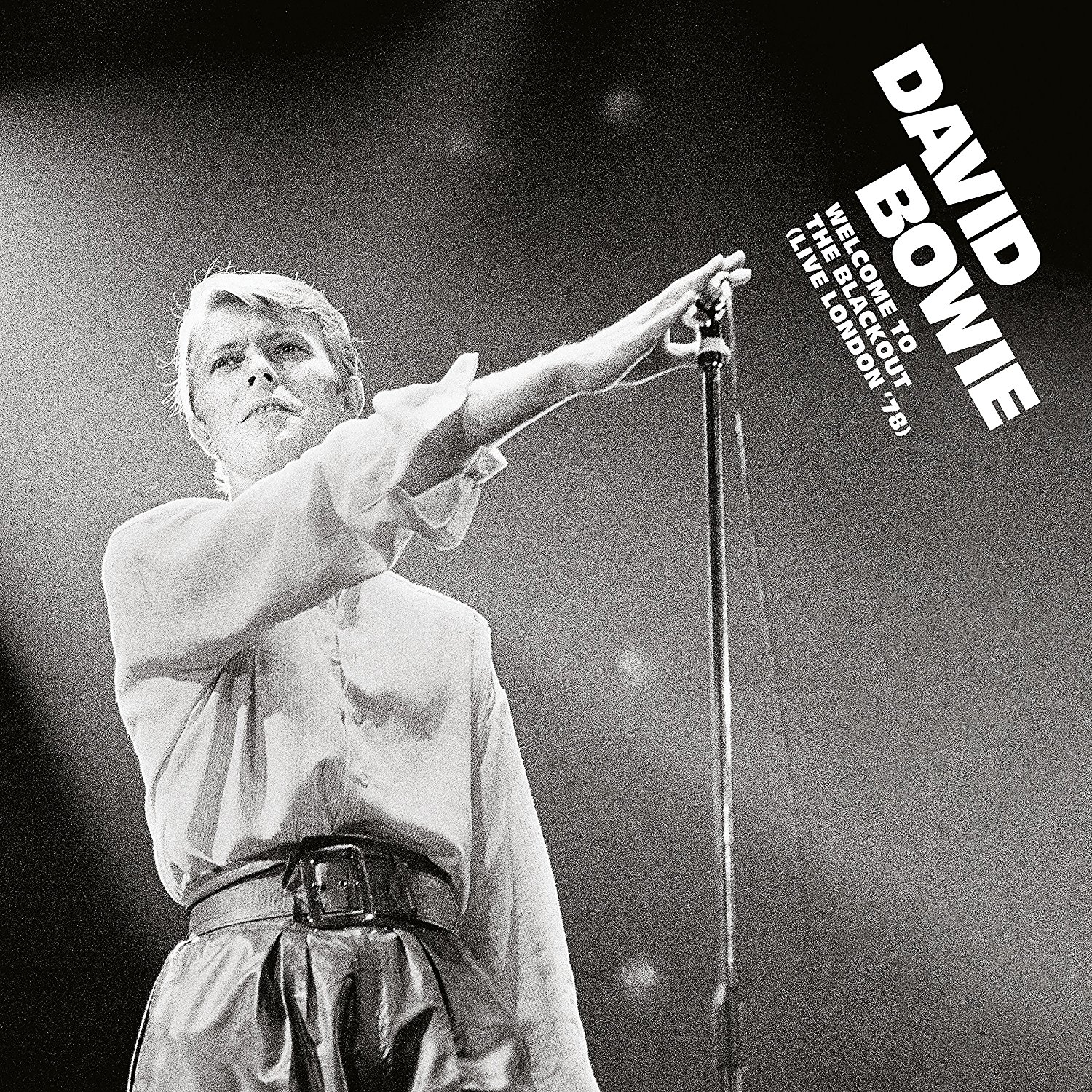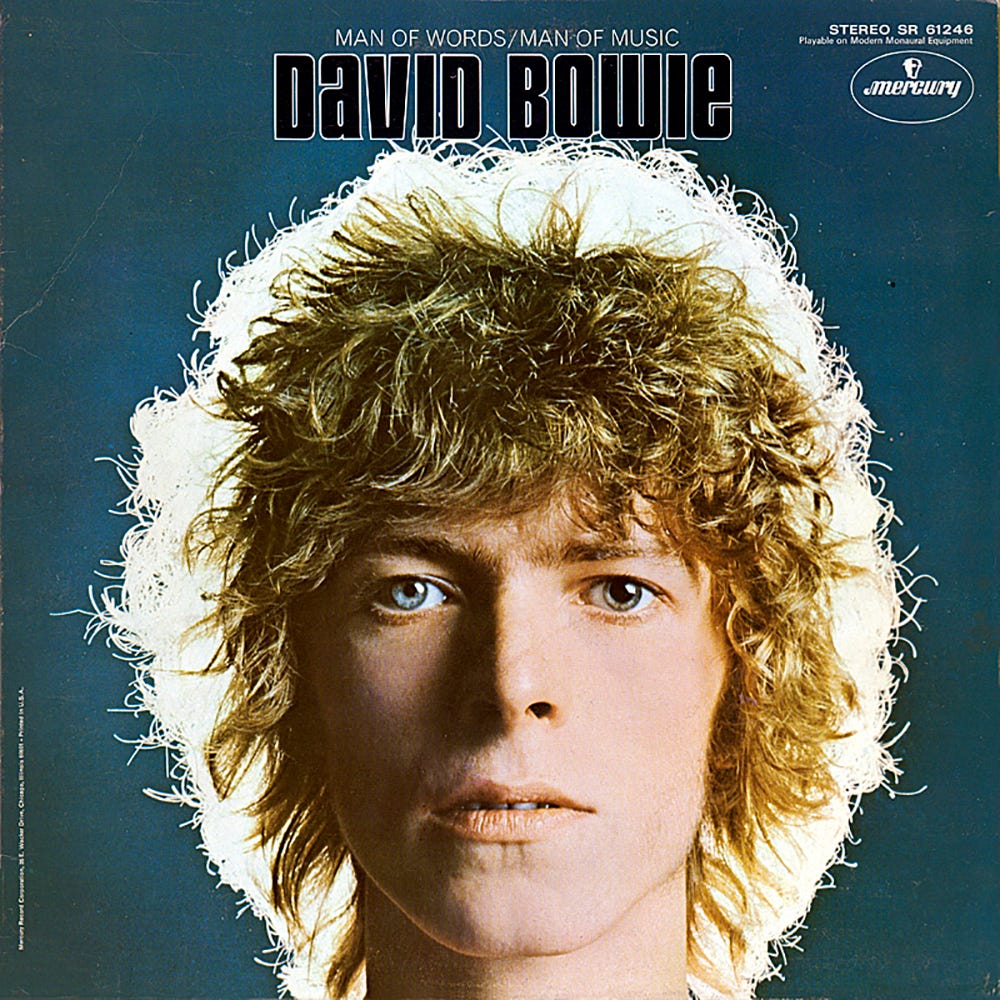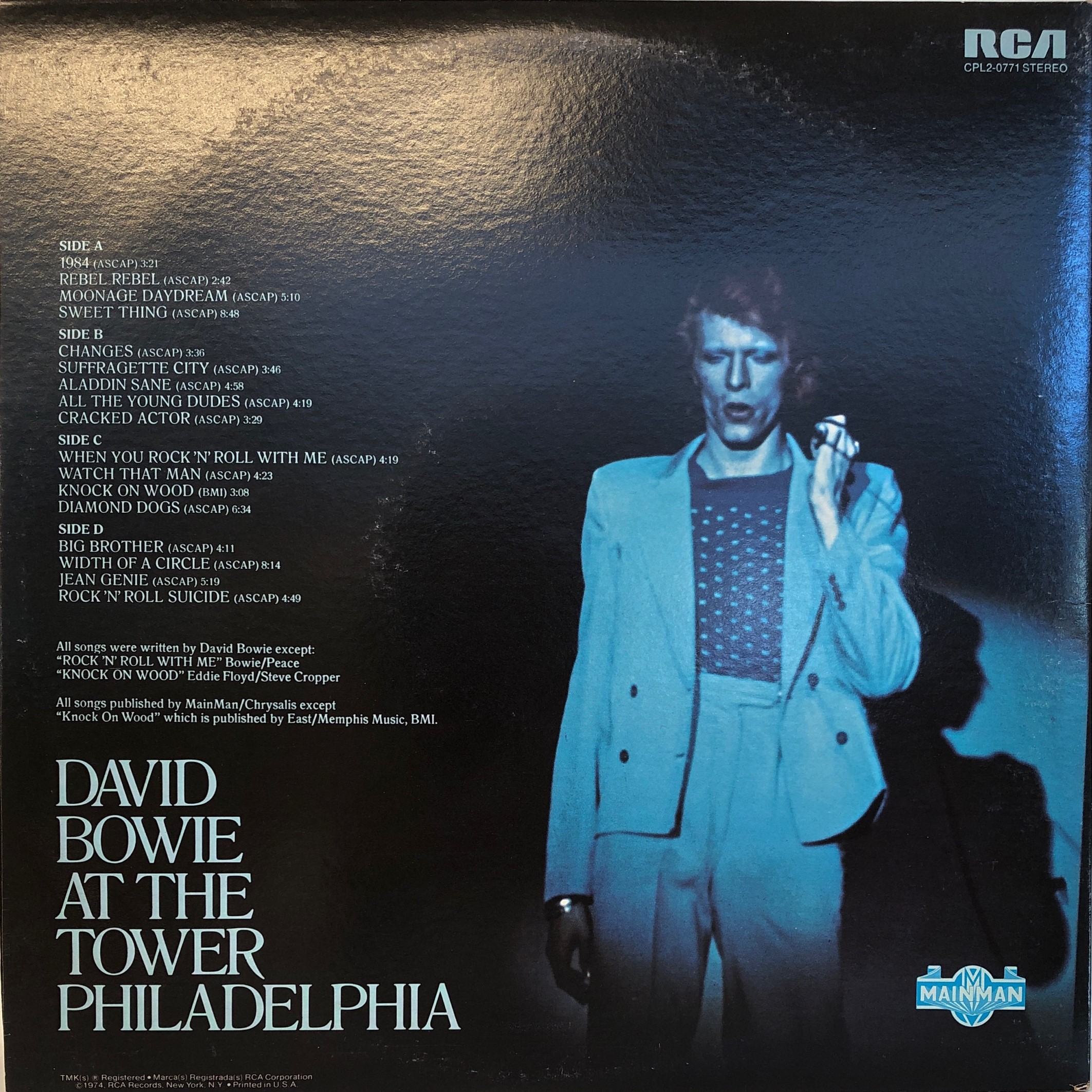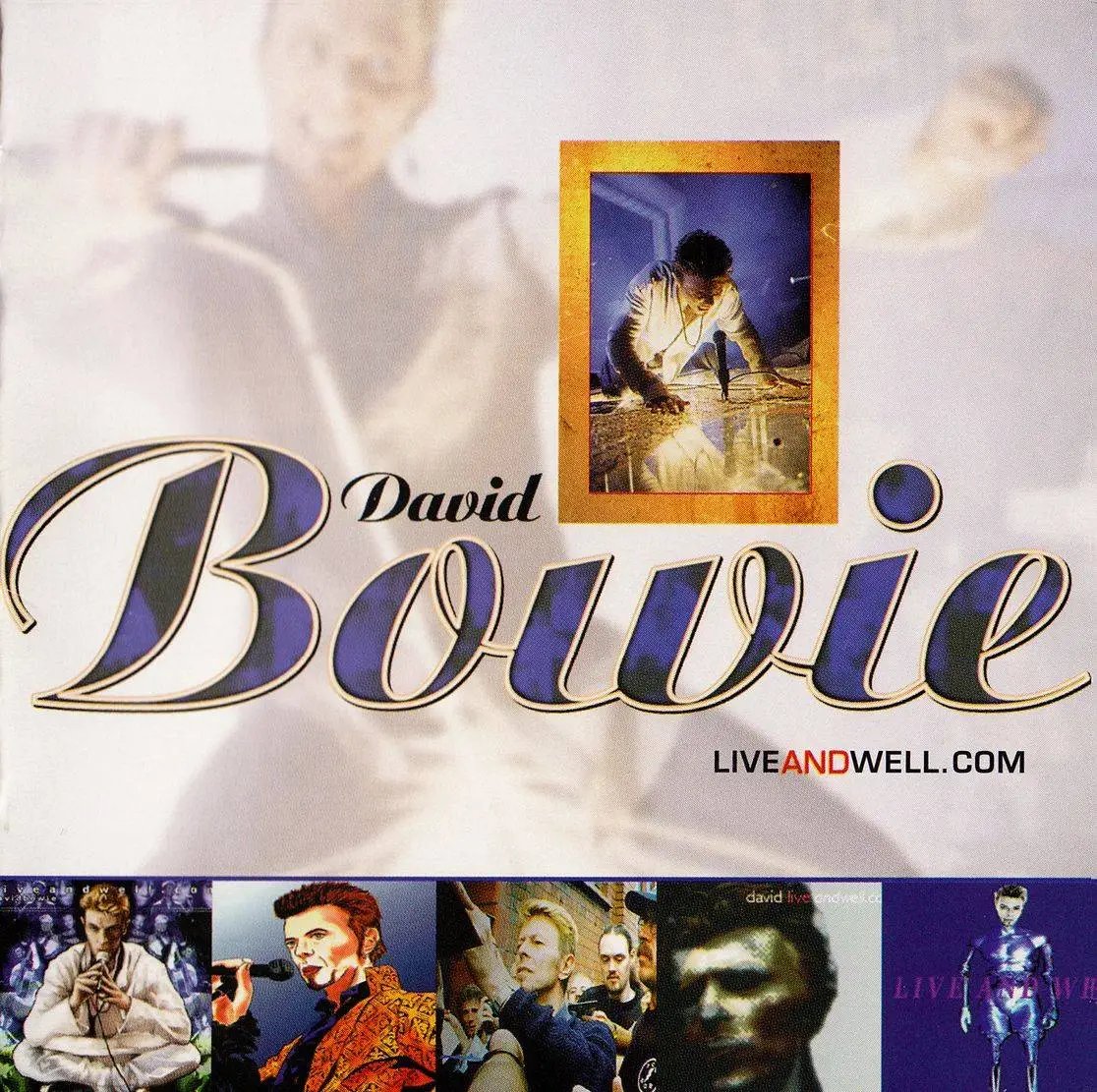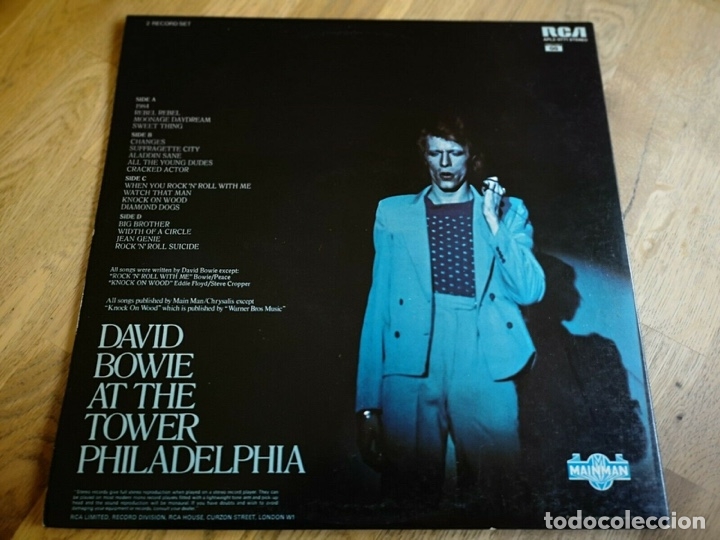In the fall of 1964, not long before his death, Sam Cooke released Sam Cooke At The Copa, a velvet-smooth live record composed of standards done in the style of mainstream pop stars like Perry Como and Nat King Cole. The album was intended to make in-roads with a white audience, which made it preferable at the time to another live album that Cooke recorded the previous year at Miami's Harlem Square Club. The much grittier Harlem Square Club recording was actually shelved by Cooke's record label for sounding too rough; it wouldn't see the light of day until 1985, at which point it immediately overshadowed Cooke's Copa album … and most other live albums. On Live At The Harlem Square Club, Cooke claims his rightful place as one of the best and most influential singers of the modern pop era. The second of three albums in a row that are just amazing.
Low is the most radically unusual album by any mainstream rock artist that was actually meant to be listened to. It's strange, fragmentary, and quite unique in its sound, but it's absolutely compelling. This follow-up to Low has a darker feel, and the songs are more like traditional songs. Brian Eno is back, and Robert Fripp on guitar really stars, especially on the magnificent title song. A bit of the white funk/soul of the previous album Young Americans continues, but it's much more sinister and challenging, especially the title track. Here is another group of three consecutive brilliant albums, this time from the start of the 1970s.
Hunky Dory is the album to play to someone who likes relatively traditional songs and needs to be convinced about Bowie. (Rick Wakeman, who has worked with countless artists on hundreds of songs, says that it was "the best song I had ever had the privilege to work on.")5. Utterly different from the albums before and after it, this one is sort of heavy metal/prog.
Dark, apocalyptic and sinister, and mostly pretty heavy, but exciting throughout. It's still brilliant, but not as brilliant as the others above it. It's hard to properly assess the worth of an album that's only been released for a few weeks, especially a Bowie album, but at the moment at least this one seems outstanding.
The title track is creepily uncomfortable in a way that only Bowie at his best can do. The album sounds like an artist thriving, rather than one on the brink of dying. The Dead have officially released more live albums than anyone on this list, along with the thousands of bootlegs of practically every concert they ever played. But this show — played on a scorchingly hot late summer day for an audience of naked, drugged-out hippies who apparently couldn't keep tabs on their kids for more than two seconds — deserves serious consideration as the best gig they ever played.
Nina Simone doesn't sing songs so much as inhabit them, digging deep into the text and subtext and manifesting its heart and soul with her one-of-a-kind voice and spirit. On her albums, the orchestrations occasionally get in the way of that voice. But on her many live albums, including this 1964 classic, Simone's ability to become whatever her material requires and make the audience feel every single word is spellbinding.
But what this album also asserts is the supreme singularity of Simone's talent. Not only was Led Zeppelin's "The Song Remains The Same" a live album, but it was also a concert film of the same name. The English rock band recorded it at Madison Square Garden over three nights in July 1973 during the band's tour for the studio album "Houses Of The Holy." One of the most definitive songs on the album is an almost 30-minute-long version of "Dazed And Confused." Heathen was released in June 2002, preceded by first single Slow Burn featuring old friend Pete Townshend on lead guitar. Dave Grohl took the same role on the Neil Young cover I've Been Waiting For You. Guest turns aside though, Bowie played more instruments on Heathen than anything in memory, including the drums over his own loop on the Pixies cover Cactus, as well as nearly all the synth work and some of the piano.
As for the album title, "Heathenism is a state of mind", Bowie explained at the time. David performed Low in its entirety alongside Heathen as part of the festival. Elton John himself has cited this as his best live recording. The album title commemorates the date that it was recorded, and on November 17, 1970, he wasn't yet a star. It's hard to imagine these days, but in 1970, Elton John was an up-and-coming artist with something to prove, and he played like his life depended on it.
He hadn't yet added guitarist Davey Johnstone to his band; back then, it was just the trio of him, bassist Dee Murray and drummer Nigel Olsson. Legend has it that Elton cut his hand during the show, and by the time it was over, the piano keys were covered with blood. After DIAMOND DOGS, YOUNG AMERICANS could have been a more conventional "plastic soul" record from a white British guy. And while it was a plastic soul record from a white British guy, YOUNG AMERICANS was not conventional in its ultimate appeal. Its title track is one of my favorite Bowie songs, an absolutely moving soul song with incredible backing vocals, and it kicks off a series of absolutely pleasing tracks.
I've used the words "fun" and "challenging" to illustrate the Bowie dichotomy of, maybe, the old "one for them, one for me" maxim you find in the film industry, but with YOUNG AMERICANS, Bowie got his cake and ate it too. It's not experimental in the way of the Berlin Trilogy or something, but after the glam rock ramp up of the past half a decade, Bowie briefly reinvented himself and made a singularly soulful album. And while it didn't send him into retirement, NEVER LET ME DOWN also caused Bowie to leave something behind. After chasing the ghost of LET'S DANCE's success throughout the '80s, a period many critics now consider the artist's fallow period, Bowie created this much maligned record. I think it's widely considered one of Bowie's worst from what I can gather, and as is clear, I nearly agree.
I don't think any artists from the '60s or '70s escaped the '80s without at least a couple of embarrassing records, but Bowie transcended trends to the point that NEVER LET ME DOWN is a little more than tolerable. But Bowie couldn't quite escape the musical tropes of the '80s, and much of the rest of the album is mired in them. It speaks to Bowie's innate musical ability, then, that NEVER LET ME DOWN ultimately isn't a slog. However, it, in addition to the massively expensive and incredibly theatrical Glass Spider tour, disillusioned Bowie in regards to his own artistic direction, and he formed the band Tin Machine to ultimately create two records and get back to his rock roots.
The albums are pretty good, but they aren't considered in this piece. Recorded on Valentine's Day 1970 at the University of Leeds, "Live At Leeds" is the English rock band's debut live album and features only six tracks, though later editions of the album have added the 27 other songs played that night. The band hoped to use recorded material from the Leeds show and another concert the following evening but discovered that the first six tracks from the other show weren't usable.
When live albums were at their height in the '70s, they were actually a way for mid-tier bands to vault to the superstar level. It was especially helpful for acts who never could seem to make studio albums that had the same vitality as their live shows. This gambit worked for arena-rockers like Kiss, Cheap Trick, and Peter Frampton, and it also worked for the LA band Little Feat, a critical favorite who finally scored a platinum album with their 1978 live set, Waiting For Columbus. While the band's studio work during the '70s was strong, Waiting For Columbus is infused with a party-hearty vibe that made it the go-to album for their growing audience. Mixing jammy rock with New Orleans funk and left-field prog flourishes, Waiting For Columbus also synched with the sound of FM radio like none of Little Feat's previous releases, making it one of the era's most recognizable live records.
"We are the innovators, they are the imitators," Jim James sings at the start of Okonokos. It might seem like a strange boast — My Morning Jacket, after all, was a southern rock band who put out a double live album at a time in the aughts when southern rock and double live albums seemed like the opposite of innovative. But the power of Okonokos is how MMJ was able to take something that might have appeared anachronistic, and execute it so well that a whole new generation could appreciate the form. Drawing mostly from the band's best albums — particularly At Dawn, It Still Moves and Z — Okonokos is unapologetically expansive and epic, demonstrating beyond a shadow of a doubt that MMJ ranks among the very best live bands of their generation. On Okonokos, they bring together the operatic emotionalism of classic rock with the exploratory weirdness of the era's best indie music. If you like live albums that are impeccably recorded and performed in a nice, orderly fashion, you will not enjoy Live In Europe.
If, however, you appreciate the sound of the best R&B singer ever dragging the best American R&B band ever, Booker T. And The MG's, through a brick wall at 100 mph, you will definitely love Live In Europe. Not long after Young Americans' release, Bowie moved to Los Angeles and starred in the cult classic Nic Roeg science fiction film The Man Who Fell To Earth. This period also saw RCA's release of David's first compilation of hits, ChangesOneBowie, in May 1976.
Never one to stay in one place too long, shortly after his tour finished, David relocated to the Schonenberg section of Berlin. Recorded with Bowie's hard rock band, Tin Machine, this is notable as the only one of his live albums that is not currently in print. A video of the same name was also released but features none of the same songs as the album. Alabama Song by David Bowie was originally released as a single in 1980. It is David Bowie's version of a Bertolt Brecht poem set to music by Kurt Weill in 1927.
As Bowie was an admirer of Brecht's work, he'd been playing the song live since 1978. This special picture disc 7" includes Alabama Song in its original single release form and a version from a 1978 concert recorded at Earl's Court, along with a version of Heroes album track Joe The Lion from the same concert. This live album may have been the one to relaunch Johnny Cash's career, which had stalled thanks to his troubles with drugs and alcohol. Though it was not Cash's first performance at Folsom, it was his first live recording at the prison—and the one that brought the song "Folsom Prison Blues," originally released in 1955, to the pop charts. A 50th Anniversary Edition of the album was released in 2018. "Live and Dangerous" came about because the Irish rock band's sessions with Tony Visconti, who had cut his teeth working with David Bowie and T.
The band's electricity on stage never seemed to translate as well on studio albums, and a live album proved to the world that they were a formidable rock force. The double album featured 17 tracks including "Emerald," "The Rocker," and fan favorite "The Boys Are Back In Town." Country singer Townes Van Zandt's career didn't take off until his live album, "'Live At The Old Quarter, Houston, Texas," which revealed a side to the artist that his listeners had yet to hear on any of his studio albums. Over five nights in a single room filled with 100 paying customers, Van Zandt proved he deserved a place among the country crooning elite. In just 90 minutes with 26 tracks, the singer found the success that had eluded him for years.
Beyoncé's 2018 Coachella performance is likely the most famous single concert of the last decade, though it is remembered primarily as a visual extravaganza. The soundtrack, however, shows that even when you strip the concert of the eye-popping spectacle, the music more than enough stands on its own. Much like the Talking Heads' Stop Making Sense, Homecoming in many ways is structured like a greatest hits album, taking the listener through the many phases of Beyoncé's career for the purpose of articulating the overall greatness of the artist.
Though what ultimately makes Homecoming a defining live album for a generation is its sense of scale — truly no other artist right now has the ability to sound this enormous without feeling any need to justify or explain that grandiosity. 1999 also saw David join Placebo at the annual BRIT Awards for a performance of the T Rex classic Twentieth Century Boy—a performance that went down so well that the UK's Mirror newspaper staged a campaign for the track to be released as a single. That July saw David voted both biggest music star of the 20th century by readers of The Sun newspaper and sixth Greatest Star of The Century by Q Magazine's readers (the Q poll also saw David place as third highest-ranking living star). "HEROES," released the same year as LOW, softened its predecessor's avant-garde leanings with stronger pop hooks.
The most significant result is the title track, one of my favorite Bowie songs, but another outcome is a more cohesive bridge between the more "conventional" side one and the more experimental side two. Otherwise, he had been turning out an ever-increasingly praised series of albums for a decade. So it's really interesting that Bowie came out of his longest hiatus yet to produce what would come to be one of his biggest successes, and one that would haunt him for the rest of the '80s. In spite of critical dismissal, LET'S DANCE is nevertheless a really good album. Bowie tapped into '80s new wave and made something richer, dirtier, and yet somehow more fun than his contemporaries. "China Girl," a version of a song Bowie had co-written with Iggy Pop for Iggy's THE IDIOT , is the best example of that on the record.
"Rust Never Sleeps" was another of the fruits of Young's tour of the same name, including a concert film and the album "Live Rust." Young used the 1978 recordings and added overdubs to both new and existing tracks, and the album was divided into electric and acoustic songs. Writing for Rolling Stone, Paul Nelson said of the album, "For anyone still passionately in love with rock 'n' roll, Neil Young has made a record that defines the territory. Defines it, expands it, explodes it. Burns it to the ground." "Live Rust" was recorded during Young's fall 1978 "Rust Never Sleeps" tour with his trusty band. It was the soundtrack to his concert film "Rust Never Sleeps," which Young directed under the pseudonym Bernard Shakey, a name he still reserves for his film work. The album includes "Sugar Mountain," a song written by the singer when he was a teen, and "After The Gold Rush," a hit from his solo career. The British psychedelic space-rock band's live double album is 88 minutes long.
It was recorded on the Doremi Fasol Latido tour and features songs "Sonic Attack," "Brainstorm," and "Masters Of The Universe." "Space Ritual" was believed by many to be one of the best live albums in its genre and reached #9 on the U.K. The title track of "Let's Dance" reached Number 1 in the U.K., U.S., and much of the rest of the world. Not only can you listen to your favorite tracks, but you can also hear the crowd and feel the energy of the performance. The quality of sound and the intensity of that well-known concert energy varies from album to album. However, there are some albums that are always going to make you nostalgic and make you feel like you are right there with the musicians.
Like The Band, Talking Heads have a less famous live album, The Name Of This Band Is Talking Heads, that is arguably better than the more famous one. I came very close to putting the less famous one on this list, but come on! You can't deny Stop Making Sense, the most ingeniously constructed live album ever, especially the complete version that was released in 1999. Actually, there's no party that's ever been that fun, except for Stop Making Sense. For decades, Van Morrison has cultivated a reputation as the surliest rock legend on the planet.
This often extends to his live performances, which he treats with the enthusiasm that most of us save for visiting the dentist's office. However, in the past, Morrison has recorded several memorable live albums, the most celebrated being It's Too Late To Stop Now, from 1974. In some ways, in terms of this Van Morrison, he was right. When Morrison later accused Bruce Springsteen of stealing his mojo, he probably had this album in mind. If I could include multiple Jimi Hendrix live albums on this list, I would have definitely also added Live At Monterey, which documents his star-marking performance at the Monterey Pop Festival in 1967.
However, if I have to pick one, I'm going with this box set covering his Band Of Gypsys concerts at the Fillmore East as New Year's Eve 1969 turned to New Year's Day 1970. Ejecting The Experience in favor of bassist Billy Cox and "fatback" drummer Buddy Miles, Songs For Groovy Children is remarkable both for the music it contains — I can never hear enough versions of "Machine Gun" — and the lost potential it hints at. Had Hendrix lived, the funky hard-rock sound of these shows suggests he would have had a pretty amazing run in the '70s.
B.B. King's career was so long and enduring that multiple generations came to know him long after he become an icon, when he was a kindly old man who rarely left his stool on stage. But in 1964, when this album was recorded at Chicago's Regal Theater, King was one of the great live acts of his era, a master with a seemingly endless array of the sweetest guitar licks on Earth, supported by a crack band with a punchy horn section. Live At The Regal captures this period beautifully, showing King at the height of his charisma and musical potency.
It goes without saying that this is some of the finest live blues you'll ever encounter, but what I love is the excited squeals of the audience. Was one hell of a sex symbol, and his interaction with the adoring Regal crowd is practically erotic. Fans and detractors alike have long accused Built To Spill of being a jam band, given their proclivity for stretching out on very long instrumental flights of fancy in concert.
Thankfully, the band also known as "the other BTS" leaned into this on their first official concert album, 2000's Live, which was recorded during their 1999 Keep It Like A Secret tour. It speaks to how well Built To Spill pulls these songs off that the other seven tracks feel slightly disappointing for not also going on for 20 minutes each. Of the dozens of live albums that Pearl Jam released from their 2000 tour, this one stands out as an especially emotional and moving performance. But the real highlight of this LP is the debut performance of "Crown Of Thorns," the Mother Love Bone oldie that Vedder revived in order to honor the long-time partnership between Jeff Ament and Stone Gossard. The gesture, and the inspired performance, is a real tearjerker.
While there is practically a live album for each of David Bowie's many guises, the one I always go back to is Live Nassau Coliseum '76, which captures his foxy, coked-out "Thin White Duke" period. At the time, Bowie was caught at a fascinating nexus point between art rock, prog, and funk, an ungainly mix that he was somehow able to communicate to thousands of people in arenas as relatively straight-forward rock music. Even a song as complicated and epic as "Station To Station" hits with tremendous power thanks to Bowie's incredible band, including the virtuoso guitarist Carlos Alomar and the powerhouse drummer Dennis Davis, who provide a smoking instrumental bed for Bowie's beguiling vamps.
